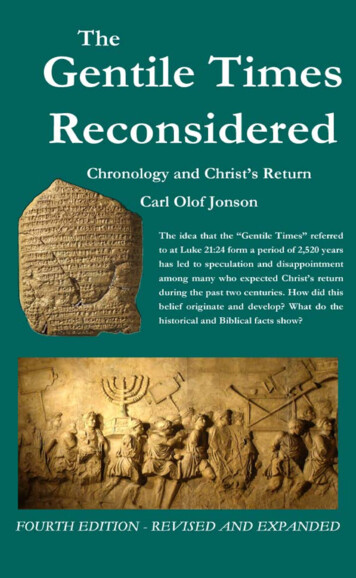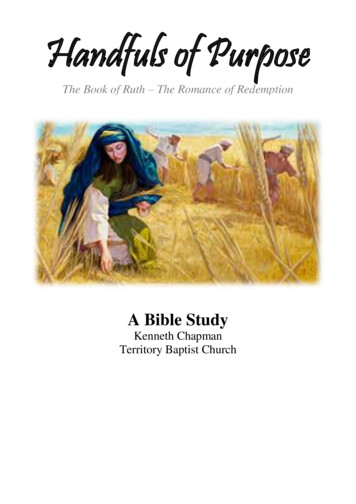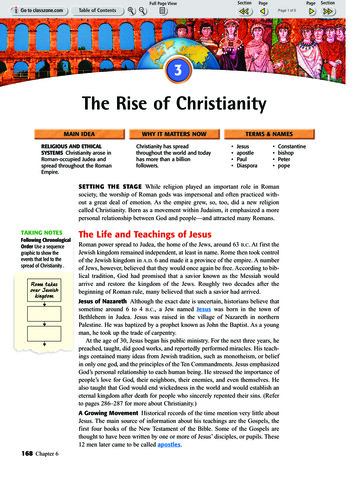
Transcription
THE GENTILE TIMESRECONSIDEREDCarl Olof JonssonFourth EditionRevised and ExpandedCOMMENTARY PRESS ATLANTA 2004
Because of its subject matter, in this book Bible texts are generallyquoted from the New World Translation (represented by theabbreviation NW), published by the Watchtower Bible and TractSociety of New York, Inc. Abbreviations for other translations ofBiblical quotations, listed in the text or in the footnotes, are:ASVKJVLXXMTNABNASBNEBNIVNKJVNRSVRSVRVAmerican Standard VersionKing James VersionSeptuagint Version (Greek)Masoretic text (Hebrew)New American BibleNew American Standard BibleNew English BibleNew International VersionNew King James VersionNew Revised Standard VersionRevised Standard VersionRevised VersionTHE GENTILE TIMES RECONSIDEREDFIRST EDITION 1983 byHart Publishers Ltd. of Lethbridge, Alta., Canada and Good NewsDefenders of La Jolla, CA, U.S.A. for Christian KoinoniaInternational.SECOND EDITION 1986Published by Commentary Press, Atlanta, GA 30336.THIRD EDITION, REVISED AND EXPANDED 1998Published by Commentary Press, Atlanta, GA 30336.FOURTH EDITION, REVISED AND EXPANDED 2004 Published by Commentary Press, Atlanta, GA30336.Internet edition: Tönis Tönisson, Vretstorp, 2009All rights reservedManufactured in the United States of AmericaISBN: 0-914675-07-9Library of Congress Catalog Card No.: 86-70168
Contents1234567ForewordIntroductionThe History of an InterpretationBiblical and Secular ChronologyThe Length of Reignsof the Neo-Babylonian KingsThe Absolute Chronologyof the Neo-Babylonian EraThe Seventy Years for BabylonThe “Seven Times” of Daniel 4Attempts to Overcome the Evidencev12372153191236283AppendixFor Chapter 1For Chapter 2For Chapter 3For Chapter 4For Chapter 5For Chapter 731231432133233535389Additional materialThe 20th year of Artaxerxes and the“Seventy weeks” of DanielProfessor Robert R. Newton, “Ptolemy’s Canon”,and the “Crime of Claudius Ptolemy”Rolf Furuli’s First Book – A Critical ReviewRolf Furuli — Sham ScholarshipRolf Furuli’s Second Book – A Critical Review394401457484Indexes551382
FOREWORDHE SUBJECT of the “Gentile times” is a crucial one today forTmillions of persons. Christ employed that phrase on a singleoccasion, as part of his response to his disciples’ question about hisfuture coming and the end of the age. In the centuries thatfollowed, numerous interpretations and time-applications of hisexpression have developed.While this book provides a remarkably broad view of the subjectit primarily focuses on one prominent interpretation, one that in avery real sense defines for millions of Jehovahs Witnesses the timein which they live, supplies what they consider a powerful criterionto judge what constitutes “the good news of the Kingdom” whichChrist said would be preached, and acts for them as a touchstonefor assessing the validity of any religious organization’s claim torepresent Christ and the interests of his Kingdom. An unusual factis that the foundation of this interpretation is a “borrowed” one,since, as the author documents, it originated nearly a half centurybefore their own religious organization began to appear on theworld scene.Rarely has a single date played such a pervasive and defining rolein a religion’s theology as has the date focused on by thisinterpretation: the date of 1914. But there is a date behind that dateand without its support 1914 is divested of its assigned significance.That prior date is 607 B.C.E. and it is the Witness religion’s linkingof that date with a particular event—the overthrow of Jerusalem byBabylon—that lies at the crux of the problem.Those of us who have shared in editing this present work andwho were ourselves, twenty-seven years ago, part of the writing andeditorial staff at the international headquarters of Jehovah’sWitnesses in Brooklyn, New York, can remember the ratherstunning effect the arrival of a treatise on the “Gentile times” fromCarl Olof Jonsson it Sweden had on us in August of 1977. Notonly the volume of the documentation, but even more so theweight of the evidence left us feeling somewhat disconcerted. Wewere, in effect, at a loss as to what to do with the material. Thattreatise later formed the basis for Carl Olof Jonsson’s book The:v
viTHE GENTILE TIMES RECONSIDEREDGentile Times Reconsidered, nowin its fourth printing.When we today read this book we become the beneficiaries ofmore than three decades of thorough and careful research. Not justthe immense amount of time, but also the means of access to thesources of information that made possible so intensive a study, aresomething very few of us would have at our disposal. The authorhas not only made use of such facilities as the British Museum butalso has had personal communication with, and assistance from,members of its staff, as also Assyriologists of various countries.The research takes us back some two and a half millennia in thepast. Many of us may think of those times as “primitive” and itthus may come as a surprise to realize how advanced certainancient peoples were, their writings covering not merely historicalevents and monarchical dynasties, but also dealing with datedbusiness documents such as ledgers, contracts, inventories, bills ofsale, promissory notes, deeds, and similar matters. Theirunderstanding of astronomy, of the progressive and cyclicalmovements of the lunar, planetary and stellar bodies, in an ageunequipped with telescopes, is extraordinary. In the light of theGenesis statement that those celestial luminaries serve to “mark thefixed times, the days and the years,” this takes on true significance,particularly in a study in which chronology plays a central role. 1Nothing, except the modern atomic clocks, surpasses thoseheavenly bodies in precision in the measurement of time.Of the quality of the research into the Neo-Babylonian period,Professor of Assyriology Luigi Cagni writes:Time and again during my reading [of Jonsson’s book] I wasovercome by feelings of admiration for, and deep satisfaction with,the way in which the author deals with arguments related to thefield of Assyriology. This is especially true of his discussion of theastronomy of Babylonia (and Egypt) and of the chronologicalinformation found in cuneiform texts from the first millenniumB.C.E., sources that hold a central position in Jonsson’sargumentation.His seriousness and carefulness are evidenced in that he hasfrequently contacted Assyriologists with a special competence inthe fields of astronomy and Babylonian chronology, such asProfessors H. Hunger, A. J. Sachs, D. J. Wiseman, Mr. C. B. F.Walker at the British Museum and others.1Genesis 1:14, NAB.
ForewordviiWith respect to the subject field I am particularly familiar with,the economic-administrative texts from the Neo-Babylonian andAchaemenid periods, I can say that Jonsson has evaluated themquite correctly. I put him to the test during the reading of thebook. When I finished the reading, I had to admit that he passedthe test splendidly?2Readers of the first or second edition of this book will findmuch that is new here. Entire sections, including some newchapters have been added. Contributing to the readability of thebook is the inclusion of about thirty illustrations, including lettersand other documents. Many of the illustrations are rare and willundoubtedly be new to most readers.The original research behind the book inescapably brought theauthor on a collision course with the Watch Tower organizationand—not unexpectedly—led to his excommunication as an“apostate” or heretic in July 1982. This dramatic story, not told inthe first two editions, is now presented in the section of theIntroduction titled “The expulsion.”The discussion of the chronology of the Neo-Babylonian periodhas been greatly expanded. The seven lines of evidence against the607 B.C.E. date presented in the first two editions have since beenmore than doubled. The evidence from astronomical texts forms aseparate chapter. The burden of evidence presented in Chapters 3and 4 is indeed enormous and reveals an insurmountabledisharmony with, and refutation of, the chronology of the WatchTower Society for this ancient period.Despite the wealth of information from ancient secular sources,this book remains primarily Biblical. In the chapter ‘Biblical andSecular Chronology” it clears up a common and seriousmisconception as to how we arrive at a ‘Biblical chronology,” asalso the erroneous idea that a rejection of the Watch Tower’s 607B.C.E. date implies a placing of secular chronology as superior tosuch “Biblical chronology.”We are confident that the reading of this unique book will aidmany to gain, not only a more accurate knowledge of the past, butalso a more enlightened outlook regarding their own time, andincreased appreciation of the trustworthiness and historicity of theScriptures.The Editors2From the preface to the Italian edition of The Gentile Times Reconsidered by LuigiCagni, Professor of Assyriology at the University of Naples, Italy. Professor Cagniwas, among other things, a leading expert on the Ebla tablets ,the about 16,000cuneiform texts that have been excavated since 1975 in the roya1 palace of theancient city of Ebla (present Arabic name: Tell Mardikh) in Syria. Luigi Cagni diedin January, 1998.
viii
THE GENTILE TIMESRECONSIDEREDINTRODUCTIONHE DISILLUSIONING and sometimes dramatic process thatended up in the decision to publish this treatise could fill aTwhole book. Due to considerations of space, however, thatbackground can be only touched upon briefly here. Jehovah’sWitnesses are taught to put great trust in the Watch Tower Societyand its leadership. Toward the end of my twenty-six years as anactive Jehovah’s Witness, however, the signs indicating that suchtrust was mistaken had mounted. To the very last I had hoped thatthe leaders of the organization would honestly face the factsrespecting their chronology, even if those facts should prove fatalto some of the central doctrines and unique claims of theirorganization. But when at last I realized that the Society’s leaders—apparently for reasons of organizational or “ecclesiastical” policy— were determined to perpetuate what, in the final analysis,amounts to a deception of millions of persons, doing this bysuppressing information which they regarded and continue toregard as undesirable, no other course seemed open to me but topublish my findings, thus giving every individual who has aconcern for truth an opportunity to examine the evidence and drawhis or her own conclusions.We are each responsible for what we know. If a person hasinformation on hand that others need in order to get a correctunderstanding of their situation in life— information that furthermore iswithheld from them by their religious leaders—then it would be morallywrong to remain silent. It becomes his or her duty to make thatinformation available to all who want to know the truth, howeverthis may appear. That is the reason why this book has beenpublished.1
2THE GENTILE TIMES RECONSIDEREDThe role of chronology in the teachings of theWatch Tower SocietyFew people are fully cognizant of the very central role played bychronology in the claims and teachings of the Watch TowerSociety. Even many of Jehovah’s Witnesses are not fully aware ofthe indissoluble connection between the Society’s chronology andthe message they preach from door to door. Confronted with themany evidences against their chronology, some Jehovah’sWitnesses tend to downplay it as something they somehow can dowithout. “Chronology is not so important, after all,” they say. ManyWitnesses would prefer not to discuss the subject at all. Just howimportant, then, is the chronology for the Watch Towerorganization?An examination of the evidence demonstrates that it constitutesthe very foundation for the claims and message of this movement.The Watch Tower Society claims to be God’s “sole channel”and “mouthpiece” on earth. Summing up its most distinctiveteachings: it asserts that the kingdom of God was established inheaven in 1914, that the “last days” began that year, that Christreturned invisibly at that time to “inspect” the Christiandenominations, and that he finally rejected all of them except theWatch Tower Society and its associates, which he appointed in1919 as his sole “instrument” on earth.For about seventy years, the Society employed Jesus’ words atMatthew 24:34 about “this generation” to teach clearly andadamantly that the generation of 1914 would positively not passaway until the final end came at the “battle of Armageddon,” whenevery human alive except active members of the Watch Towerorganization would be destroyed forever. Thousands of Jehovah’sWitnesses of the “1914 generation” fully expected to live to see andto survive that doomsday and then to live forever in paradise onearth.As decades went by, leaving 1914 ever farther behind, this claimbecame increasingly difficult to defend. After 80 years had passed,the claim became virtually preposterous. So, in the November 1,1995, issue of the Watchtower (pages 10 through 21), a newdefinition of the phrase “this generation” was adopted, one thatallowed the organization to “unlink” it from the date of 1914 as astarting point. Despite this monumental change, they still retained the1914 date—in fact they could not do otherwise without dismantlingtheir major teachings regarding Christ’s “second presence,” thestart of the “time of the end,” and the appointment of their
Introduction31914 — The Generation That Would not pass away!organization as Christ’s unique instrument and God’s sole channelon earth. Though now recognizing “this generation” as defined byits characteristics rather than by a chronological period (with aparticular starting point), they still found a way to include 1914 intheir new definition. They accomplished this by including in the
4THE GENTILE TIMES RECONSIDEREDdefinition an arbitrarily added factor, namely, that the “generation”is composed of “those persons who see the sign of Christ’spresence but fail to mend their ways,” resulting in their destruction.Since the official teaching continues to be that the “sign of Christ’spresence” became visible from and after 1914, this allows for thedate’s continuing to form a key part of the definition of “thisgeneration.”All these factors, then, bear testimony to the highly crucial rolethat 1914 plays in the teaching of the Watch Tower Society. Sincethe date itself obviously is not stated in Scripture, what is itssource?That date is a product of a chronological calculation, accordingto which the so-called “times of the Gentiles” referred to by Jesusat Luke 21:24 constitute a period of 2,520 years, beginning in 607B.C.E. and ending in 1914 CE.1 This calculation is the real basis of theprincipal message of the movement. Even the Christian gospel, the “goodnews” of the kingdom (Matthew 24:14), is claimed to be closelyassociated with this chronology. The gospel preached by otherprofessed Christians, therefore, has never been the true gospel. SaidThe Watchtower of May 1, 1981, on page 17:Let the honest-hearted person compare the kind of preachingof the gospel of the Kingdom done by the religious systems ofChristendom during all the centuries with that done by Jehovah’sWitnesses since the end of World War I in 1918. They are not oneand the same kind. That of Jehovah’s Witnesses is really “gospel,”or “good news,” as of God’s heavenly kingdom that was established by theenthronement of his Son Jesus Christ at the end of the Gentile Times in 1914.[Italics mine.]In agreement with this, The Watchtower of May 1, 1982, statedthat, “of all religions on earth, Jehovah’s Witnesses are the onlyones today that are telling the people of earth this ‘good news’.”(Page 10) A Jehovah’s Witness who attempts to tone down the roleof chronology in the Society’s teaching simply does not realize thathe or she thereby radically undermines the major message of themovement. Such a “toning down” is not sanctioned by the1The designations “B.C.E.” (Before the Common Era) and “C.E.” (Common Era)customarily used by Jehovah’s Witnesses, correspond to “B.C” and “A.D.” They areoften used in scholarly literature, especially by Jewish authors, and have beenadopted by the Watch Tower Society , as will be seen in the subsequent quotationsfrom the Watch Tower publications . For the sake of consistency, thesedesignations, B.C.E. and C.E., are regularly used in this work, the exception beingwhere material is quoted in which the B.C. and A.D. designations are employed.
Introduction5Watch Tower leadership. On the contrary, The Watchtower ofJanuary 1, 1983, page 12, emphasized that “the ending of theGentile Times in the latter half of 1914 still stands on a historicalbasis as one of the fundamental Kingdom truths to which we must holdtoday.”2The hard reality is that the Watch Tower Society views rejectionof the chronology pointing to 1914 as a sin having fatalconsequences. That God’s kingdom was established at the end ofthe “Gentile times” in 1914 is stated to be “the most importantevent of our time,” beside which “all other things pale intoinsignificance.”3 Those who reject the calculation are said to incurthe wrath of God. Among them are “the clergy of Christendom”and its members, who, because they do not subscribe to that date,are said to have rejected the kingdom of God and therefore will be“destroyed in the ‘great tribulation’ just ahead.”4 Members ofJehovah’s Witnesses who openly question or discard the calculationrun the risk of very severe treatment. If they do not repent andchange their minds, they will be disfellowshipped and classified asevil “apostates,” who will “go, at death, . . . to Gehenna,” with nohope of a future resurrection.5 It makes no difference if they stillbelieve in God, the Bible, and Jesus Christ. When one of thereaders of The Watchtower wrote and asked, “Why have Jehovah’sWitnesses disfellowshipped (excommunicated) for apostasy some2345Italics and emphasis added. The Watch Tower Society’s former president, FrederickW. Franz, in the morning Bible discussion for the headquarters family onNovember 17, 1979, stressed even more forcefully the importance of the 1914 dateby saying: “The sole purpose of our existence as a Society is to announce theKingdom established in 1914 and to sound the warning of the fall of Babylon theGreat. We have a special message to deliver.” (Raymond Franz, In Search ofChristian Freedom, Atlanta: Commentary Press, 1991, pp. 32, 33).The Watchtower, January 1, 1988, pp. 10, 11.The Watchtower, September 1, 1985, pp. 24, 25.The Watchtower, April 1, 1982, p. 27. In The Watchtower of July 15, 1992, page 12,such dissidents are described as “enemies of God” who are “intensely hatingJehovah.” The Witnesses, therefore, are urged to “hate” them “with a completehatred.” This exhortation was repeated in The Watchtower of October 1, 1993, page19, where the “apostates” are stated to be so “rooted in evil” that “wickedness hasbecome an inseparable part of their nature.” The Witnesses are even told to askGod to kill them, in imitation of the psalmist David, who prayed of his enemies: “Othat you, O God, would slay the wicked one!” In this way the Witnesses “leave it toJehovah to execute vengeance” Such rancorous attacks on former members of theorganization reflect an attitude that is exactly the reverse of that recommended byJesus in his Sermon on the Mount.—Matthew 5:43–48.
6THE GENTILE TIMES RECONSIDEREDwho still profess belief in God, the Bible, and Jesus Christ?” theSociety answered, among other things:Approved association with Jehovah’s Witnesses requiresaccepting the entire range of the true teachings of the Bible,including those Scriptural beliefs that are unique to Jehovah’sWitnesses. What do such beliefs include? . . . That 1914 marked theend of the Gentile times and the establishment of the Kingdom of God in theheavens, as well as the time for Christ’s foretold presence. [Italics mine]6No one, therefore, who repudiates the calculation that the“Gentile times” expired in 1914, is approved by the Society as oneof Jehovah’s Witnesses. In fact, even one who secretly abandons theSociety’s chronology and thus may still formally be regarded as oneof Jehovah’s Witnesses, has, in reality, rejected the essentialmessage of the Watch Tower Society and, according to theorganization’s own criterion, is factually no longer a part of themovement.How this research beganFor one of Jehovah’s Witnesses to question the validity of thisbasic prophetic calculation is, then, no easy matter. To manybelievers, especially in a closed religious system such as the WatchTower organization, the doctrinal system functions as a sort of“fortress” inside which they may seek shelter, in the form ofspiritual and emotional security. If some part of that doctrinalstructure is questioned, such believers tend to react emotionally;they take a defensive attitude, sensing that their “fortress” is underattack and that their security is threatened. This defense mechanismmakes it very difficult for them to listen to and examine thearguments on the matter objectively. Unwittingly, their need foremotional security has become more important to them than theirrespect for truth.To reach behind this defensive attitude so common amongJehovah’s Witnesses in order to find open, listening minds isextremely difficult—especially when so basic a tenet as the“Gentile times” chronology is being questioned. For suchquestioning rocks the very foundations of the Witness doctrinalsystem and therefore often causes Witnesses at all levels to becomebelligerently defensive. I have repeatedly experienced suchreactions ever since 1977 when I first presented the material in thisvolume to the Governing Body of Jehovah’s Witnesses.6The Watchtower, April 1, 1986, pp. 30,31.
Introduction7It was in 1968 that the present study began. At the time, I was a“pioneer” or full-time evangelist for Jehovah’s Witnesses. In thecourse of my ministry, a man with whom I was conducting a Biblestudy challenged me to prove the date the Watch Tower Societyhad chosen for the desolation of Jerusalem by the Babylonians, thatis 607 B.C.E. He pointed out that all historians marked that eventas having occurred about twenty years later, in either 587 or 586B.C.E. I was well aware of this, but the man wanted to know thereasons why historians preferred the latter date. I indicated thattheir dating surely was nothing but a guess, based on defectiveancient sources and records. Like other Witnesses, I assumed thatthe Society’s dating of the desolation of Jerusalem to 607 B.C.E.was based on the Bible and therefore could not be upset by thosesecular sources. However, I promised the man I would look intothe matter.As a result, I undertook a research that turned out to be farmore extensive and thoroughgoing than I had expected. Itcontinued periodically for several years, from 1968 until the end of1975. By then the growing burden of evidence against the 607B.C.E. date forced me reluctantly to conclude that the WatchTower Society was wrong.Thereafter, for some time after 1975, the evidence was discussedwith a few close, research-minded friends. Since none of themcould refute the evidence demonstrated by the data I had collected,I decided to develop a systematically composed treatise on thewhole question which I determined to send to the headquarters ofthe Watch Tower Society at Brooklyn, New York.That treatise was prepared and sent to the Governing Body ofJehovah’s Witnesses in 1977. The present work, which is based onthat document, was revised and expanded during 1981 and thenpublished in a first edition in 1983. During the years that havepassed since 1983, many new finds and observations relevant to thesubject have been made, and the most important of these havebeen incorporated in the last two editions. The seven lines ofevidence against the 607 B.C.E. date presented in the first edition,for example, have now been more than doubled.Correspondence with the Watch Tower headquartersIn 1977 I began to correspond with the Governing Bodyconcerning my research. It soon became very evident that theywere unable to refute the evidence produced. In fact, there was noteven an attempt made to do so until February 28, 1980. In the
8THE GENTILE TIMES RECONSIDEREDmeantime, however, I was repeatedly cautioned not to reveal myfindings to others. For example, in a letter from the GoverningBody dated January 17, 1978, the following warning was given:However, no matter how strong the argumentation maybe in support of those views, they must, for thepresent, be regarded as your personal viewpoint. It isnot something that you should talk about or trytoadvance among other members of the congregation.7And further, in a letter dated May 15, 1980, they stated:We are sure you appreciate that it would not beappropriate for you to begin to state your views andconclusions on chronology that are different thanthose published by the Society so as to raise seriousquestions and problems among the brothers.8I accepted such advice, as I was given the impression that myspiritual brothers at the Watch Tower headquarters needed time toreexamine the whole subject thoroughly. In their first reply to mytreatise, dated August 19, 1977, they had stated: “We are sorry thatthe press of work here has not allowed us to give it the attentionwe would like to up to the present time.” And in the letter ofJanuary 17,1978, they wrote:We have not had the opportunity of examining this material ethisoccupyingmaterialourwhen weattention.havetheopportunity. You can be assured that your views will beexamined by responsible brothers. In due course we hope tolook into your treatise and evaluate what is contained therein.Judging from these and similar statements, Watch Towerofficials at the Brooklyn headquarters seemed prepared to examinethe data presented to them honestly and objectively. In a very shorttime, however, the whole matter took quite a different course.Interrogation and defamationEarly in August, 1978, Albert D. Schroeder, a member of theGoverning Body, held a meeting in Europe with representatives7Names of the authors of letters from the Watch Tower Society are never given.Instead, internal symbols are used. The symbol “GEA” in the upper left corner ofthis letter shows that the author was Lloyd Barry, one of the members of theGoverning Body.8. The symbol “EF” shows the writer of this letter to have been Fred Rusk of theWriting Department.
Introduction9
10THE GENTILE TIMES RECONSIDEREDfrom European Watch Tower branch offices. At that meeting, hetold the audience that there was a campaign going on both insidethe movement and from outside to have the Society’s 607 B.C.E.–1914 C.E. chronology overthrown.9 The Society, however, had nointention of abandoning it, he stated.Three weeks later, on September 2, I was summoned to ahearing before two representatives of the Watch Tower Society inSweden, Rolf Svensson, one of the two district overseers in thecountry, and Hasse Hulth, a circuit overseer. I was told that theyhad been commissioned by the Society’s branch office to hold sucha hearing because “the brothers” at the Brooklyn headquarterswere deeply concerned about my treatise. Once again I wascautioned not to spread the information I had gathered. RolfSvensson also told me that the Society did not need or wantindividual Jehovah’s Witnesses to become involved in research ofthis kind.Partly as a result of this meeting, I resigned from my position asan elder in the local congregation of Jehovah’s Witnesses and alsofrom all my other tasks and assignments in the congregation andthe circuit. I did this in the form of a lengthy letter, addressed tothe local eldership and the circuit overseer, Hasse Hulth, in which Ibriefly explained the reasons for the position I had taken. Soon itbecame widely known among my Witness brothers in differentparts of Sweden that I had rejected the chronology of the Society.In the following months, I and others who had questioned thechronology began to be condemned privately as well as from theplatforms of Kingdom Halls (congregational meeting places) and atWitness assemblies or conventions. We were publicly characterizedin the most negative terms as “rebellious,” “presumptuous”, “falseprophets,” “small prophets who have worked out their own littlechronology,” and “heretics.” We were called “dangerous elementsin the congregations,” “evil slaves,” “blasphemers,” as well as“immoral, lawless ones.” Privately, some of our Witness brothers,including a number of the Watch Tower Society’s travelingrepresentatives, also intimated that we were “demon-possessed,”that we had “flooded the Society with criticism” and that we“should have been disfellowshipped long ago” These are just a9Except for my treatise, which came from inside the movement, Schroeder couldhave had in mind two non-Witness publications which attack the Society’schronology: The Jehovah’s Witnesses and Prophetic Speculation, by Edmund C.Gross (Nutley, N. J.: Presbyterian and Reformed Publishing Co., 1972), and 1914and Christ’s Second Coming by William MacCarty (Washington, D. C.: Review andHerald Publishing Association, 1975).
Introduction11few examples of the widespread defamation, one that has gone onever since, although no names, for obvious legal reasons, have everbeen mentioned publicly.That such obvious slander was not just a local phenomenon, buthad the sanction of the Governing Body of Jehovah’s Witnesses,was evident from the fact that similar statements were printed inThe Watchtower magazine.10This description of the situation that developed has not beengiven in order to criticize Jehovah’s Witnesses as individuals. Thesepeople are usually kind and sincere in their belief. The descriptionhas rather been given to illustrate how easily an individual mayunwittingly fall prey to the irrational, psychological r
ASV American Standard Version KJV King James Version LXX Septuagint Version (Greek) MT Masoretic text (Hebrew) NAB New American Bible NASB New American Standard Bible NEB New English Bible NIV New International Version NKJV New King James Version NRSV New Revised Standard Version RSV Revised Standard Version R










